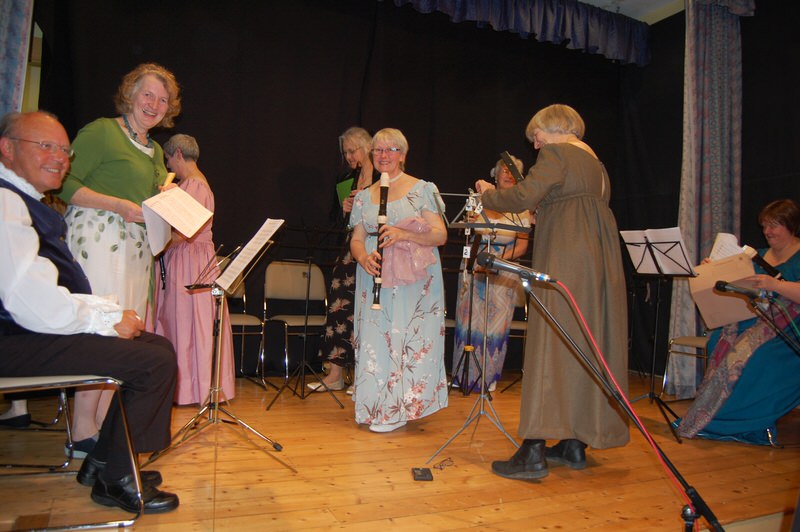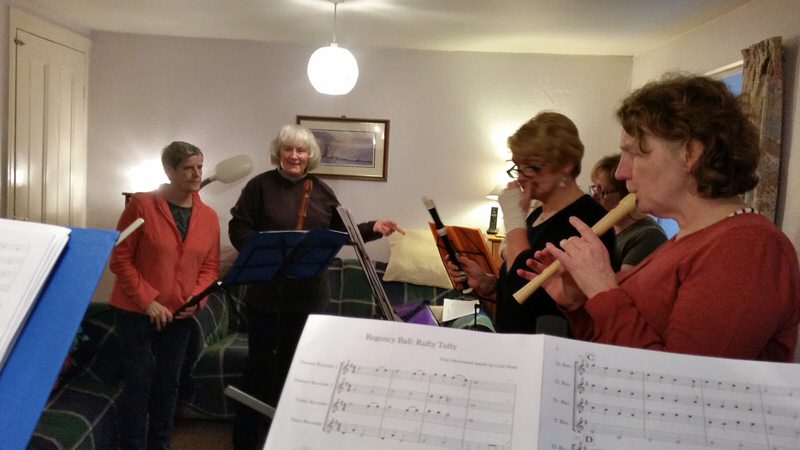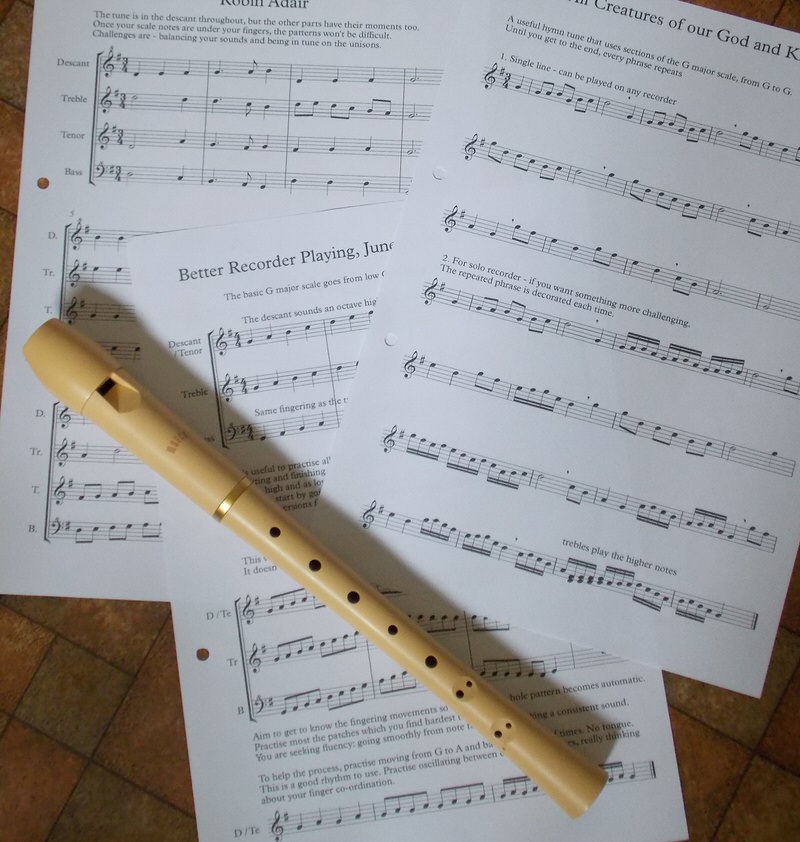Better Recorder Playing
In the autumn of 2016, we ran a Start the Recorder course, for people who wanted to start or resurrect recorder playing. By spring 2019, members of the original group were ready to learn more and others were keen to join in and improve their skills.
As a result, we started a Better Recorder Playing course. This aimed, over a year, to help people improve their playing, guiding them through technical and musical barriers, and encouraging them to practise.
Each month was a new bundle of materials covering individual technique and ensemble playing. There are were two opportunities to meet for a couple of hours in the month – people come to one or both as they were able.
Lock down interrupted the course with three months to go. We set up a Google Group, and materials are sent out, now, it has to be said, on a rather random basis. All members of the group are sent the materials and video links for Slow Tunes, as another means of sort of playing with other people.
Once we can meet again, we'll pick up the threads of the course. New members are welcome.
Better Recorder Playing by June 2020
About the Course
This is a course for people who enjoy playing the recorder, can play many of the notes and straightforward rhythms, and would like to improve their skills, especially in an ensemble, whether purely for pleasure or to share with others through performance. The course is suitable for any size of recorder, and participants will be encouraged to have a go at other sizes.
By the end of the course, participants should be able to:
play fluently throughout the range of the instrument in the most commonly used 10 keys
have a range of tonguing patterns and be able to apply them appropriately
play accurately and expressively music at an intermediate level
be a confident and competent member of a recorder ensemble with one instrument to a part, both in terms of playing, and rehearsing together effectively without a conductor
be able to read at sight at a level appropriate to their performance skills
tackle music from the 15th to the 17th century with understanding of the styles, structures, textures and rhythm
By June 2020, participants completing the course will be approximately at the level required for ABRSM Grade IV, although the course is not focussed on taking an exam, or, indeed, giving performances.
There are two sessions a month, one on a Monday and one on a Wednesday afternoon in the hopes that all who would like to attend can fit at least one in. Both sessions in the month cover the same content. People are welcome to come to both. The first half hour or so focusses on technique – mainly fingering and tonguing, and the remaining time is spent on ensemble skills.
There's a pack of music provided for each month containing everything needed, but people are encouraged to supplement this with other music they have or find. It's useful to have a music stand both for the sessions and for practice at home.
In order to make progress, participants need to be able to do some practice in between sessions. Ideally, at least some members will be able to get together from time to time to work as ensembles.
We meet at members' houses, so there is no cost for room hire. Felton Music provides the music packs – 50p a month from each participant covers the printing costs of those.
Better Recorder Playing: Year Plan
| Date | Fingering | Tonguing | Solo playing | Ensemble playing |
|---|---|---|---|---|
| 2019 June | G major scale* practising oscillating between adjacent notes | “Basic” tonguing – single soft tongue stroke to start the note. Full length notes | Tunes that use the G major scale. Decorated figures in tunes that ask for fluency, using sections of the scale 0 | Listening to the whole - unanimity of timing and tone. |
| 2019 July | F major scale short motif repeated on each note of the scale | Co-ordinating fingers and tongue. Staccato tonguing – starting and finishing the note with the tongue | Tunes that use the F major scale. Tunes that call for staccato tonguing | Fundamental skills for playing from a score without a conductor: start and end, keep a steady beat, identify and deal with issues, keep going after individual tangles |
| 2019 Aug | C major scale G, F and C major scales in thirds | Slurred notes Slur two, tongue two | Phrasing in order to shape the music, identifying good breathing places | Preparing one's part from score – phrasing and identifying what is going on in others' parts. Contrapuntal music. |
| 2019 Sep | G major arpeggio, “straight” and overlapping. D7 arpeggio | Combinations of all three types of tonguing | Analysing the structure of a piece and varying the articulation on repeats | 16th century dance music. Forms, speed, rhythms, including cross rhythms |
| 2019 Oct | F and C major arpeggios in a range of patterns C7 and G7 arpeggios | Pieces with divisions | Working on a piece independently and shaping it for perfomance | 16th / 17th century imitative music. Responding to what other players do in imitative music. Bringing out imitative motifs |
| 2019 Nov | Consolidation of scales and arpeggios | Playing all scales and arpeggios so far with a variety of articulation patterns | Checking out the tuning of own instrument using tuner and ear. Adjusting tuning of individual notes | Tuning held chords in 16th / 17th century music. Preparing a piece to lead next time. |
| 2019 Dec | Aeolian, Dorian and Mixolydian modes on C, D, F, G and A | (remaining content will be planned later) | Lyrical modal pieces from different times | Taking the lead at a rehearsal as a playing member of the ensemble. |
| 2020 Jan | E minor scale, harmonic and melodic, E minor arpeggio and B7 arpeggio | (remaining content will be planned later) | Working as a group to rehearse, using a score: hearing issues and having an agreed way of stopping, analysing, picking up, strategies for sorting out tricky places | |
| 2020 Feb | D min scale, harmonic and melodic, D min and A7 arpeggio | Making the music work effectively as a group – identify and articulate suggestions. Explore different ways of playing bits | ||
| 2020 Mar | A min scale, harmonic and melodic, A min and E7 arpeggio | Playing from individual parts instead of the score. | ||
| 2020 Apr | D maj and B min scales and argeggios | Playing parts without bar lines – 16th, 17th century music | ||
| 2020 May | Bb maj and G min scales and arpeggios | Coping with syncopation in 20th century music | ||
* All scales and arpeggios are for the full range of the instrument



